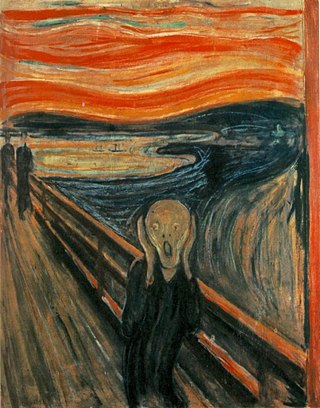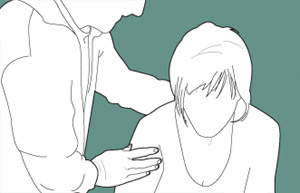Related Research Articles

Anxiety is an emotion which is characterised by an unpleasant state of inner turmoil and includes feelings of dread over anticipated events. Anxiety is different from fear in that fear is defined as the emotional response to a real threat, whereas anxiety is the anticipation of a future threat. It is often accompanied by nervous behavior such as pacing back and forth, somatic complaints, and rumination.

A phobia is an anxiety disorder, defined by an irrational, unrealistic, persistent and excessive fear of an object or situation. Phobias typically result in a rapid onset of fear and are usually present for more than six months. Those affected go to great lengths to avoid the situation or object, to a degree greater than the actual danger posed. If the object or situation cannot be avoided, they experience significant distress. Other symptoms can include fainting, which may occur in blood or injury phobia, and panic attacks, often found in agoraphobia and emetophobia. Around 75% of those with phobias have multiple phobias.

Anxiety disorders are a cluster of mental disorders characterized by significant and uncontrollable feelings of anxiety and fear such that a person's social, occupational, and personal functions are significantly impaired. Anxiety may cause physical and cognitive symptoms, such as restlessness, irritability, easy fatigue, difficulty concentrating, increased heart rate, chest pain, abdominal pain, and a variety of other symptoms that may vary based on the individual.

Agoraphobia is a mental and behavioral disorder, specifically an anxiety disorder characterized by symptoms of anxiety in situations where the person perceives their environment to be unsafe with no easy way to escape. These situations can include public transit, shopping centers, crowds and queues, or simply being outside their home on their own. Being in these situations may result in a panic attack. Those affected will go to great lengths to avoid these situations. In severe cases, people may become completely unable to leave their homes.

Panic attacks are sudden periods of intense fear and discomfort that may include palpitations, sweating, chest pain or chest discomfort, shortness of breath, trembling, dizziness, numbness, confusion, or a feeling of impending doom or of losing control. Typically, symptoms reach a peak within ten minutes of onset, and last for roughly 30 minutes, but the duration can vary from seconds to hours. Although they can be extremely frightening and distressing, panic attacks themselves are not physically dangerous.
Specific phobia is an anxiety disorder, characterized by an extreme, unreasonable, and irrational fear associated with a specific object, situation, or concept which poses little or no actual danger. Specific phobia can lead to avoidance of the object or situation, persistence of the fear, and significant distress or problems functioning associated with the fear. A phobia can be the fear of anything.

Claustrophobia is a fear of confined spaces. It is triggered by many situations or stimuli, including elevators, especially when crowded to capacity, windowless rooms, and hotel rooms with closed doors and sealed windows. Even bedrooms with a lock on the outside, small cars, and tight-necked clothing can induce a response in those with claustrophobia. It is typically classified as an anxiety disorder, which often results in panic attacks. The onset of claustrophobia has been attributed to many factors, including a reduction in the size of the amygdala, classical conditioning, or a genetic predisposition to fear small spaces.

Panic is a sudden sensation of fear, which is so strong as to dominate or prevent reason and logical thinking, replacing it with overwhelming feelings of anxiety, uncertainty and frantic agitation consistent with a fight-or-flight reaction. Panic may occur singularly in individuals or manifest suddenly in large groups as mass panic.

Arousal is the physiological and psychological state of being awoken or of sense organs stimulated to a point of perception. It involves activation of the ascending reticular activating system (ARAS) in the brain, which mediates wakefulness, the autonomic nervous system, and the endocrine system, leading to increased heart rate and blood pressure and a condition of sensory alertness, desire, mobility, and reactivity.

In psychology and psychotherapy, existential crises are inner conflicts characterized by the impression that life lacks meaning or by confusion about one's personal identity. Existential crises are accompanied by anxiety and stress, often to such a degree that they disturb one's normal functioning in everyday life and lead to depression. This negative attitude towards life and meaning reflects various positions characteristic of the philosophical movement known as existentialism. Synonyms and closely related terms include existential dread, existential vacuum, existential neurosis, and alienation. The various aspects associated with existential crises are sometimes divided into emotional, cognitive, and behavioral components. Emotional components refer to the feelings they provoke, such as emotional pain, despair, helplessness, guilt, anxiety, or loneliness. Cognitive components encompass the problem of meaninglessness, the loss of personal values or spiritual faith, and reflections about one's own mortality. Outwardly, existential crises often express themselves in addictions, anti-social and compulsive behavior.
Test anxiety is a combination of physiological over-arousal, tension and somatic symptoms, along with worry, dread, fear of failure, and catastrophizing, that occur before or during test situations. It is a psychological condition in which people experience extreme stress, anxiety, and discomfort during and/or before taking a test. This anxiety creates significant barriers to learning and performance. Research suggests that high levels of emotional distress have a direct correlation to reduced academic performance and higher overall student drop-out rates. Test anxiety can have broader consequences, negatively affecting a student's social, emotional and behavioural development, as well as their feelings about themselves and school.
Exposure therapy is a technique in behavior therapy to treat anxiety disorders.

Dental fear, or dentophobia, is a normal emotional reaction to one or more specific threatening stimuli in the dental situation. However, dental anxiety is indicative of a state of apprehension that something dreadful is going to happen in relation to dental treatment, and it is usually coupled with a sense of losing control. Similarly, dental phobia denotes a severe type of dental anxiety, and is characterised by marked and persistent anxiety in relation to either clearly discernible situations or objects or to the dental setting in general. The term ‘dental fear and anxiety’ (DFA) is often used to refer to strong negative feelings associated with dental treatment among children, adolescents and adults, whether or not the criteria for a diagnosis of dental phobia are met. Dental phobia can include fear of dental procedures, dental environment or setting, fear of dental instruments or fear of the dentist as a person. People with dental phobia often avoid the dentist and neglect oral health, which may lead to painful dental problems and ultimately force a visit to the dentist. The emergency nature of this appointment may serve to worsen the phobia. This phenomenon may also be called the cycle of dental fear. Dental anxiety typically starts in childhood. There is the potential for this to place strains on relationships and negatively impact on employment.
Social anxiety is the anxiety and fear specifically linked to being in social settings. Some categories of disorders associated with social anxiety include anxiety disorders, mood disorders, autism spectrum disorders, eating disorders, and substance use disorders. Individuals with higher levels of social anxiety often avert their gazes, show fewer facial expressions, and show difficulty with initiating and maintaining a conversation. Social anxiety commonly manifests itself in the teenage years and can be persistent throughout life; however, people who experience problems in their daily functioning for an extended period of time can develop social anxiety disorder. Trait social anxiety, the stable tendency to experience this anxiety, can be distinguished from state anxiety, the momentary response to a particular social stimulus. Half of the individuals with any social fears meet the criteria for social anxiety disorder. Age, culture, and gender impact the severity of this disorder. The function of social anxiety is to increase arousal and attention to social interactions, inhibit unwanted social behavior, and motivate preparation for future social situations.

Nomophobia is a word for the fear of, or anxiety caused by, not having a working mobile phone. It has been considered a symptom or syndrome of problematic digital media use in mental health, the definitions of which are not standardized for technical and genetical reasons.
An anxiety threshold is the level of anxiety that, when reached, can affect a person's performance. Anxiety is an emotion, similar to fear, that can be created by insecurities in one's abilities, concerns for the future, such as financial or situational circumstances, or past memories of frightening experiences. Anxiety can affect all age groups and if fears are irrational, it may cause mental disorders. An individual's anxiety threshold can be measured by the amount of anxiety consistently manifested from situation to situation.

In psychology, stress is a feeling of emotional strain and pressure. Stress is a type of psychological pain. Small amounts of stress may be beneficial, as it can improve athletic performance, motivation and reaction to the environment. Excessive amounts of stress, however, can increase the risk of strokes, heart attacks, ulcers, and mental illnesses such as depression and also aggravation of a pre-existing condition.
Chronophobia, also known as prison neurosis, is considered an anxiety disorder describing the fear of time and time moving forward, which is commonly seen in prison inmates. Next to prison inmates, chronophobia is also identified in individuals experiencing quarantine due to COVID-19. As time is understood as a specific concept, chronophobia is categorized as a specific phobia.
Human factors are the physical or cognitive properties of individuals, or social behavior which is specific to humans, and influence functioning of technological systems as well as human-environment equilibria. The safety of underwater diving operations can be improved by reducing the frequency of human error and the consequences when it does occur. Human error can be defined as an individual's deviation from acceptable or desirable practice which culminates in undesirable or unexpected results.
Dive safety is primarily a function of four factors: the environment, equipment, individual diver performance and dive team performance. The water is a harsh and alien environment which can impose severe physical and psychological stress on a diver. The remaining factors must be controlled and coordinated so the diver can overcome the stresses imposed by the underwater environment and work safely. Diving equipment is crucial because it provides life support to the diver, but the majority of dive accidents are caused by individual diver panic and an associated degradation of the individual diver's performance. - M.A. Blumenberg, 1996
Future tripping, also referred to as anticipatory anxiety, describes a type of fear that occurs when an anticipated event in the future causes distress. These events can include both major occasions, such as a presentation, but depending on the individual could also happen before some minor event, like going out. It is not seen as a distinct type of anxiety but rather plays a part in many variations and can be found in numerous disorders and is strongly connected to panic attacks, often following them.
References
- ↑ "Pucker Factor | Definition of Pucker Factor by Oxford Dictionary on Lexico.com also meaning of Pucker Factor". Lexico Dictionaries | English. Archived from the original on June 11, 2022. Retrieved 2020-08-26.
- 1 2 "Know Your Military Terminology: The Pucker Factor". SOFREP. 2013-07-17. Retrieved 2020-08-26.
- ↑ Safire, William (1988-07-07). "Opinion | ESSAY; The Pucker Factor". The New York Times. ISSN 0362-4331 . Retrieved 2023-06-15.